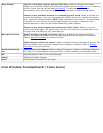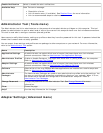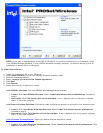
NOTE: This setting takes effect when either Infrastructure or Ad hoc mode is used.
Wireless Mode
Select which band to use for connection to a wireless network:
● 802.11a only: Connect the wireless adapter to 802.11a networks only
● 802.11b only: Connect the wireless adapter to 802.11b networks only
● 802.11g only: Connect the wireless adapter to 802.11g networks only.
● 802.11a and 802.11g only: Connect the wireless adapter to 802.11a and
802.11g networks only.
● 802.11b and 802.11g only: Connect the wireless adapter to 802.11b and
802.11g networks only
● 802.11a, 802.11b, and 802.11g: (Default) - Connect to either 802.11a,
802.11b or 802.11g wireless networks.
NOTE: These wireless modes (Modulation type) determine the discovered access points
displayed in the
Wireless Networks list.
OK
Saves settings and returns to the previous page.
Cancel
Closes and cancels any changes.
Advanced Statistics (Advanced menu)
Provides current adapter connection information. The following describes information for the Advanced Statistics page.
Name Description
Statistics
Advanced Statistics: This information pertains to how the adapter communicates with
an access point.
Association: If the adapter finds an access point to communicate with, the value is in
range. Otherwise, the value is out of range.
● AP MAC Address: The twelve digit MAC address (00:40:96:31:1C:05) of
the AP.
● Number of associations: The number of times the access point has found
the adapter.
● AP count: The number of available access points within range of the wireless
adapter.
● Number of full scans: The number of times the adapter has scanned all
channels for receiving information.
● Number of partial scans: The number of scans that have been terminated.
Roaming: This information contains counters that are related to reasons for the adapter
roaming. Roaming occurs when an adapter communicates with one access point and then
communicates with another for better signal strength.
● Roaming Count: The number of times that roaming occurred.
● AP did not transmit: The adapter did not receive radio transmission from
the access point. You may need to reset the access point.
● Poor beacon quality: The signal quality is too low to sustain communication
with the access point. You have moved the adapter outside the coverage
area of the access point or the access point's device address information has
been changed.
● AP load balancing: The access point ended its association with the adapter
based on the access point's inability to maintain communication with all its
associated adapters. Too many adapters are trying to communicate with one
access point.
● AP RSSI too low: The Receive Signal Strength Indicator (RSSI) is too low to
maintain an association with the adapter. You may have moved outside the
coverage area of the access point or the access point could have increased


















